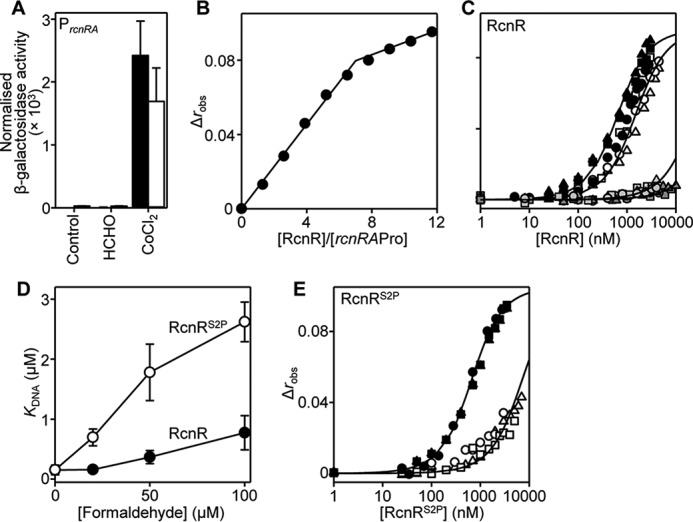FIGURE 7.

RcnR is less formaldehyde-responsive but RcnRS2P gains reactivity. A, β-galactosidase activity in SL1344 containing rcnR-PrcnRA (solid bars) or rcnRS2P-PrcnRA (open bars) fused to lacZ grown to mid-exponential phase in M9 minimal medium in the absence or presence of MNIC formaldehyde (50 μm) or CoCl2 (1 μm). Values are means of three biological replicates (each performed in triplicate) with S.D. (error bars). B and C, anisotropy change upon titration of a high concentration of rcnRAPro (2.5 μm) with RcnR in the presence of 5 mm EDTA (B) or a limiting concentration of rcnRAPro (10 nm) with RcnR in the presence of 5 mm EDTA (black symbols) and with the addition of 50 μm formaldehyde (open symbols) or Ni(II)-RcnR (light gray symbols) and Co(II)-RcnR (dark gray symbols) in the presence of 5 μm NiCl2 or 5 μm CoCl2, respectively (C). Symbol shapes represent individual experiments. Data were fit to a model describing a 2:1 protein tetramer (nondissociable)/DNA stoichiometry (binding with equal affinity) (50, 86), and lines represent simulated curves produced from the average (apparent) KDNA determined across the experimental replicates shown. D, apparent KDNA values of RcnR (black symbols) and RcnRS2P (open symbols) with increasing formaldehyde concentration. Values are means of three replicates with S.D. E, as described in C except with RcnRS2P in the presence of 5 mm EDTA (black symbols) and with the addition of 50 μm formaldehyde (open symbols).
